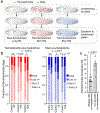An excreted small molecule promotes C. elegans reproductive development and aging
- PMID: 31320757
- PMCID: PMC6650165
- DOI: 10.1038/s41589-019-0321-7
An excreted small molecule promotes C. elegans reproductive development and aging
Abstract
Excreted small-molecule signals can bias developmental trajectories and physiology in diverse animal species. However, the chemical identity of these signals remains largely obscure. Here we report identification of an unusual N-acylated glutamine derivative, nacq#1, that accelerates reproductive development and shortens lifespan in Caenorhabditis elegans. Produced predominantly by C. elegans males, nacq#1 hastens onset of sexual maturity in hermaphrodites by promoting exit from the larval dauer diapause and by accelerating late larval development. Even at picomolar concentrations, nacq#1 shortens hermaphrodite lifespan, suggesting a trade-off between reproductive investment and longevity. Acceleration of development by nacq#1 requires chemosensation and is dependent on three homologs of vertebrate steroid hormone receptors. Unlike ascaroside pheromones, which are restricted to nematodes, fatty acylated amino acid derivatives similar to nacq#1 have been reported from humans and invertebrates, suggesting that related compounds may serve signaling functions throughout metazoa.
Figures





References
Methods-only References
-
- Sulston J & Hodgkin J Methods. (1988).
-
- Seydoux G, Savage C & Greenwald I Isolation and characterization of mutations causing abnormal eversion of the vulva in Caenorhabditis elegans. Dev Biol 157, 423–436 (1993). - PubMed
Publication types
MeSH terms
Substances
Grants and funding
LinkOut - more resources
Full Text Sources
Medical

